Wemyss and District Tramways Company Limited
Summary
In the early years of the system, which opened in 1906, motormen and conductors wore double-breasted jackets with two rows of four buttons (three on the main body of the jacket and one between the lapel and the collar); the buttons were brass and carried the full company title around the swan and motto of the Wemyss family (see link). Initially, the collars appear not to have borne any insignia. Caps were in a military style with a glossy peak and tensioned crown (top), and bore a large, round cap badge bearing the full company title around the circumference, with the swan and motto ('je pense') of the Wemyss family in the centre. These badges have survived in both gilt and nickel; it is however unclear what meaning, if any, the two materials have in terms of the period used or staff seniority.
A new issue of uniforms in 1908 comprised jackets of blue serge with yellow velvet collars; the latter bore individual metal initials, 'W & D T', on the bearer's right-hand side and an employee number on the left-hand side. A smaller cap badge was introduced around the same time, though details remain unknown as no examples are known to have survived. Photos also suggest that the yellow collars did not last long, maybe one or two years, though once again, this is far from certain.
Several photos exist showing both motormen and conductors wearing flat caps and informal attire, whilst another shows a crew in lancer-style tunics, suggesting that these were also tried for a short period. The crew in the latter photo are also wearing the older large-pattern cap badge, which lends some credence to the theory that uniform policy in the years between 1910 and 1912 may have been somewhat relaxed, i.e., uniforms being sourced piecemeal and old cap badges being re-used, or even no uniform provided at all. This remains however, pure speculation.
In 1912, when control of the company passed to George Balfour, and the Wemyss family interest ended, uniforms were changed to chocolate brown with yellow piping, and though still double-breasted, there were now two rows of five buttons (four on the main body and one between the lapel and the collar). The large round cap badge and fully titled company buttons were dispensed with at the same time, the former by standard, 'off-the-shelf', script-lettering Motorman and Conductor badges, and the latter by plain, scallop-rimmed buttons. This was presumably because it was no longer appropriate to use the armorial device and motto of the Wemyss family. The new badges and buttons were probably in brass, though this cannot be stated with certainty. Although the 'W & D T' collar initials persisted right through to the 1920s, these were eventually changed to 'WDTCo', but with the 'WD' on the bearer's right-hand collar and 'TCo' on the left-hand collar. Jackets were changed one final time — probably in the late 1920s — to a single-breasted style with two breast pockets (with button closures) and lapels; the upper part of the latter (the collars) appear to have carried some form of insignia, probably embroidered, though this cannot unfortunately be made out on surviving photographs.
The company minute book records that badges were also issued for 'good conduct and good service', though what form these took is currently unclear. My thanks to Alan Brotchie for this information.
Inspectors wore the same double-breasted jackets as motormen and conductors, but with Inspector in embroidered script lettering on each lapel collar. Caps bore a braided hat band of a noticeably lighter colour than the rest of the uniform. In later years (i.e., after the Great War) the hat bands bore 'Inspector' in embroidered script lettering. The Chief Inspector wore the same uniform, but with Chief Inspector rather than Inspector.
Women were employed as conductresses in considerable numbers during the Great War, and unlike the vast majority of UK tramway systems, they continued to be employed after the war and right through to the closure of the system. Female staff were initially issued with tailored, double-breasted jackets with lapels, and long matching skirts; the lapels bore individual system initials, 'W' on the bearer's right-hand side and 'T' on the bearer's left. Headgear took the form of a rather inelegant, dark-coloured straw bonnet that bore a cap badge comprising the system initials, 'W & D T', above a small script-lettering 'Conductor' badge. By the early 1920s, the jackets had been changed to a long, single-breasted design, which seems to have been quickly superseded by a shorter double-breasted design with lapels; the lapels bore the same badge as the men's did in these later years, namely 'WDTCo' initials, with 'WD' on the bearer's right-hand collar and 'TCo' on the left-hand collar. The pudding basin bonnets were replaced by caps shortly after the Great War - these were in a rather unusual 'American' style with a glossy peak and baggy, angular top, and were simply adorned with a standard, off-the-shelf, script-lettering 'Conductor' grade badge.
Ladies' jackets were changed one last time in the late 1920s to a single-breasted design with waist belt, two-breast pockets (with button closures) and lapels; the latter appear to have borne some kind of embroidered insignia. These new jackets were worn with a matching knee-length skirt, much shorter than previously issued.
For a detailed account of the tramway, see 'Wemyss and District Tramways' by Alan W Brotchie (N B Traction; 1976).
Images
Motormen and conductors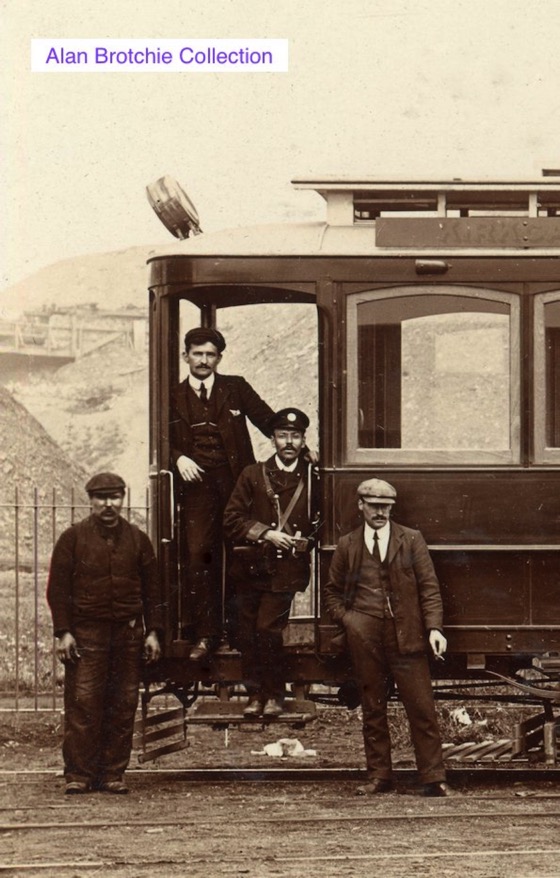
W&DTCo conductor and various other employees stand with a brand-new single-deck tramcar at Aberhill Depot — photo taken during the week of the 24th September 1906. The conductor is wearing a double-breasted jacket with lapels, and a military-style cap with a large round cap badge, almost certainly the same type as that shown below.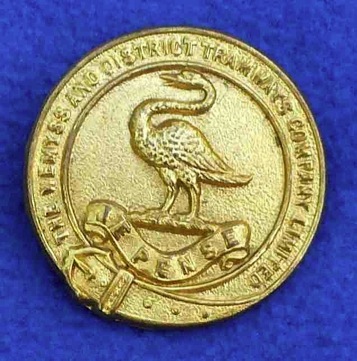
Large pattern Wemyss and District Tramways cap badge — gilt. This appears to have been worn from the opening in 1906 through to 1912. Author's Collection.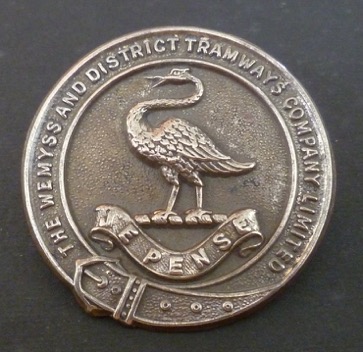
Large pattern Wemyss and District Tramways cap badge — nickel. It is currently unclear what the difference in material signifies. Author's Collection.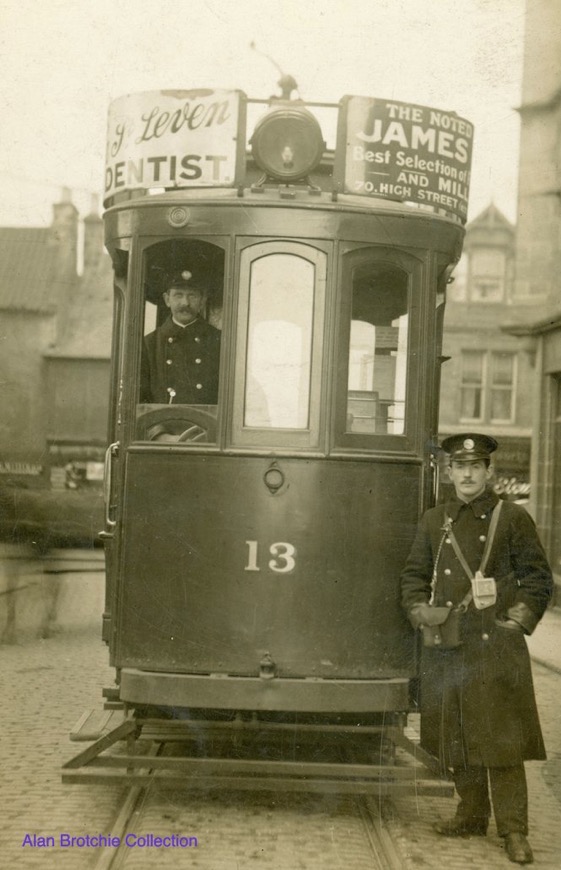
Motorman and conductor, both in double-breasted overcoats with Tramcar No 13 — photo undated, but possibly taken around 1907 or 1908, though it may well be later.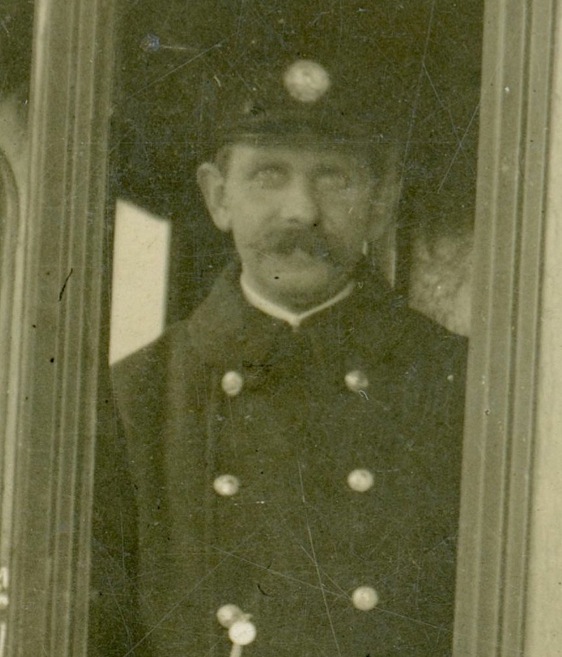
A blow-up of the above photo showing the motorman, who is clearly wearing the large pattern cap badge with the Wemyss swan (see above).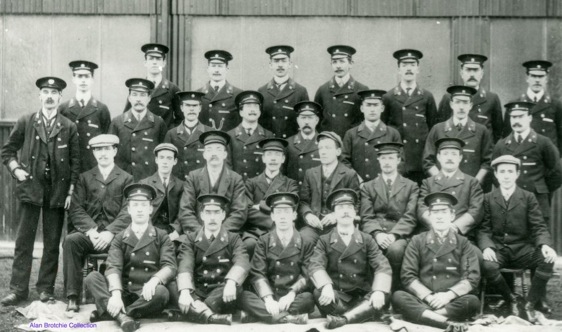
Staff photo taken at Aberhill Depot — undated, but possibly taken in 1908, when a new uniform issue was made with yellow, velvet collars. All the tramcar staff, bar the individual standing on the extreme left, are wearing a small round cap badge, whereas the aforementioned individual is wearing the much larger pattern badge seen in the majority of photos taken between 1906 and 1908.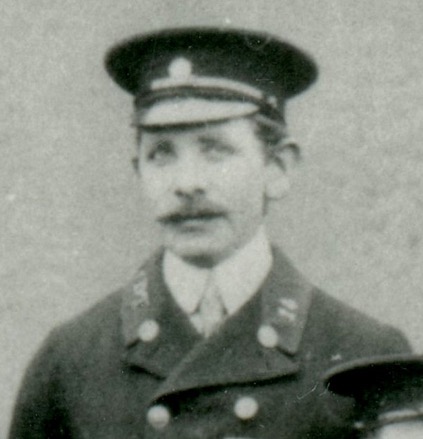
A blow-up of the above photo showing Employee No 14. The cap badge is noticeably smaller than the larger pattern of badge shown above. The collars bear material of a lighter colour, suggesting that the photo was taken in or shortly after 1908.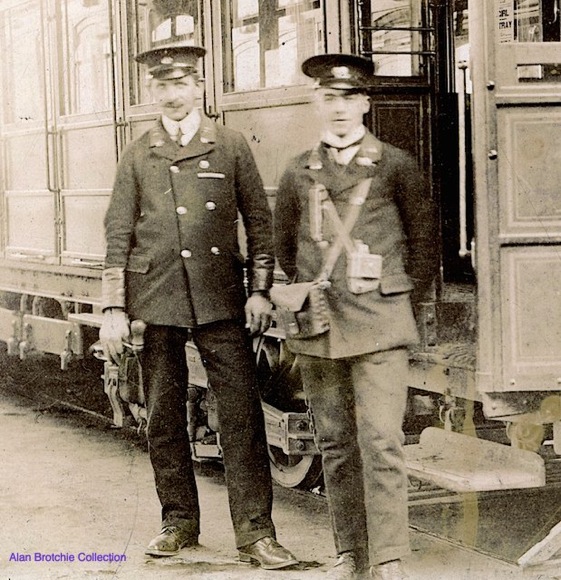
Motorman and conductor with Tramcar No 15 - photo undated, but probably taken in the late Edwardian era. Both subjects appear to have moved whilst the photo was being taken, giving the impression of an oval cap badge, whereas in all probability it is the small round cap badge. The jackets are the early double-breasted, four-button variety (3 on the body and one between the lapel and the collar), but now with yellow collars bearing employee numbers (on the left-hand side) and system initials (on the right-hand side). The yellow collars were introduced in 1908.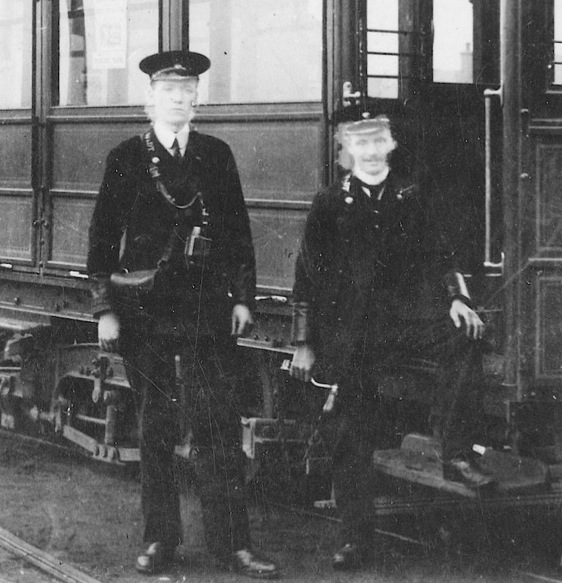
Conductor and motorman with Tramcar No 17 — owned by the Wemyss Coal Company — photo undated, but probably taken in the late Edwardian era. Both men are wearing the small pattern cap badge seen in the Aberhill staff photo above, though they do not have the yellow collars, suggesting that these were dropped at some point.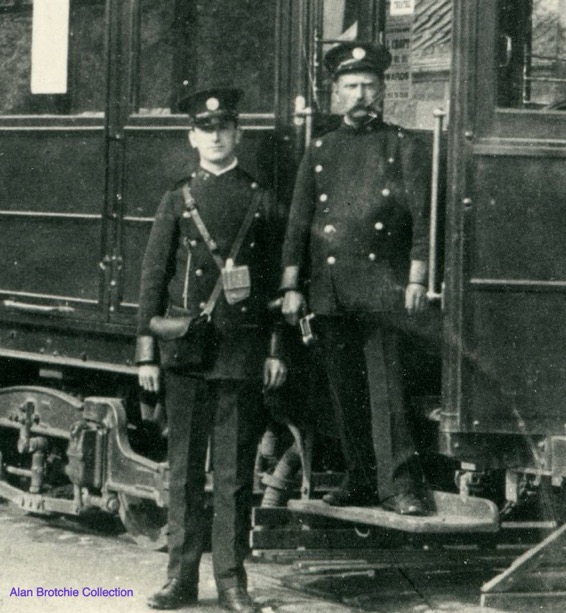
Conductor and motorman, both in 'lancer style' tunics and with caps bearing the large round cap badge, again with Tramcar No 15 — photo undated, but definitely taken prior to the Balfour take-over of 1912. This is the only photo known showing this style of uniform, so in all probability it was only worn for a short period, perhaps one or two years. The photo suggests that the large-pattern cap badges were re-used at some point, though it is hard to state this with certainty given the difficulties in accurately dating the image.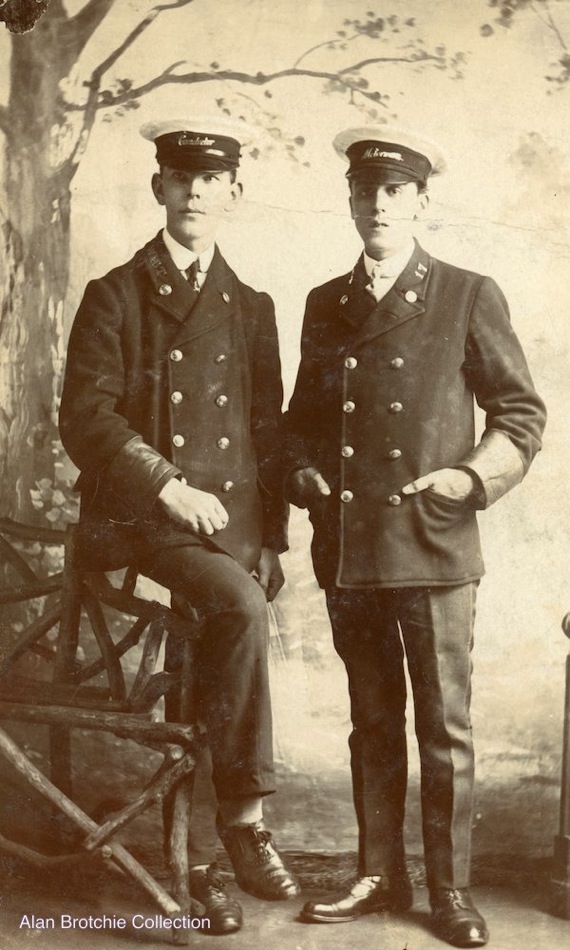
An excellent studio portrait of a conductor and motorman — photo undated, but probably taken shortly before the Great War. Note the switch to standard, off-the-shelf, script-lettering grade badges, and double-breasted jackets with two rows of five buttons, four on the body of the jacket and one between the lapel and the collar.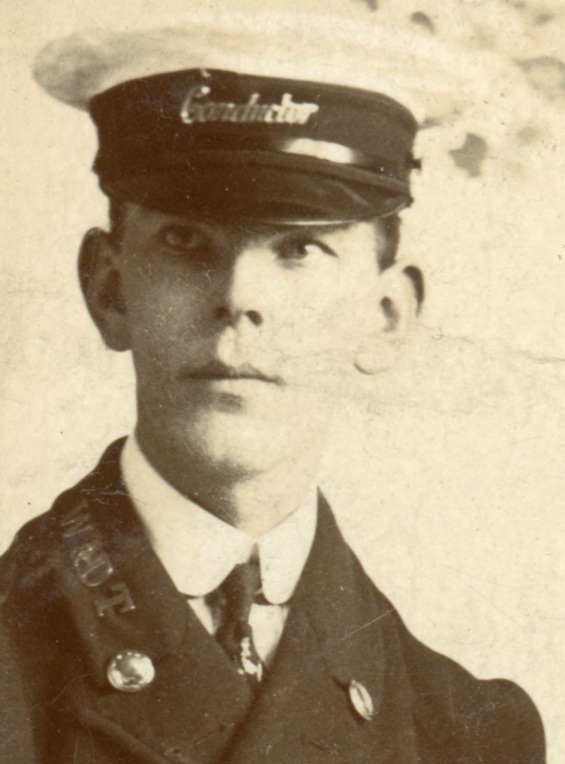
A blow-up of the above photo showing details of the conductor's collar insignia, 'W & D T'. The original fully titled buttons (see link) had by this time been replaced with plain, scalloped rim buttons; the latter are easily made out on the shot.
General pattern script-lettering cap badges of the type worn by Wemyss staff from around 1912 through to closure of the system — brass. It is however unclear which material — brass or nickel - Wemyss actually used.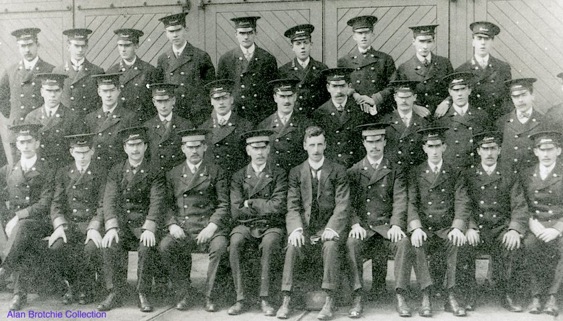
Staff photo showing motormen, conductors, two inspectors and the Chief Inspector (fifth from the left, front row) at Aberhill Depot — photo undated, but probably taken between 1912 and the start of the Great War. 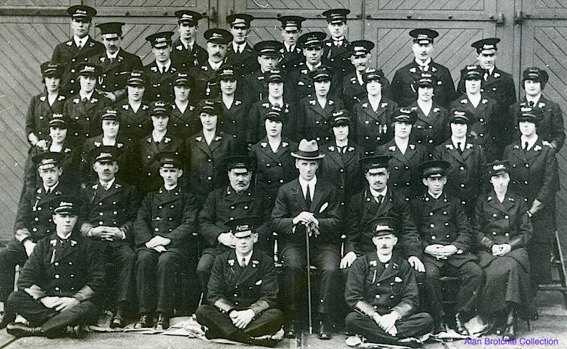
Staff photo showing motormen, conductors, conductresses, three inspectors and the Chief Inspector (fourth from the left, second row) at Aberhill Depot - undated, but probably taken in the early-to-mid 1920s.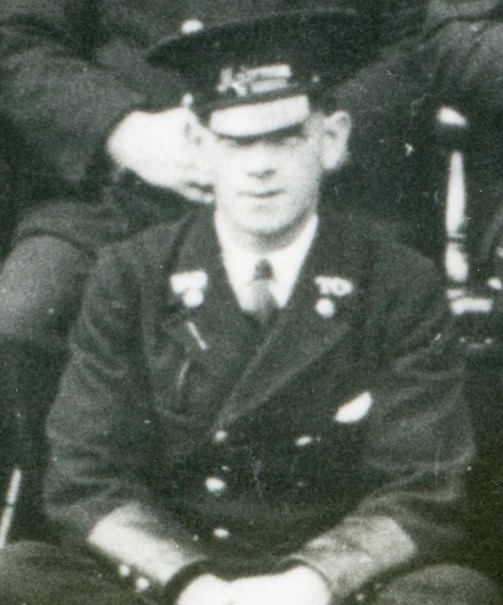
A blow-up of the above photo showing one of the motormen. The collar badges read 'WD' and 'TCo', but rather unusually for a tramway system, split across each collar.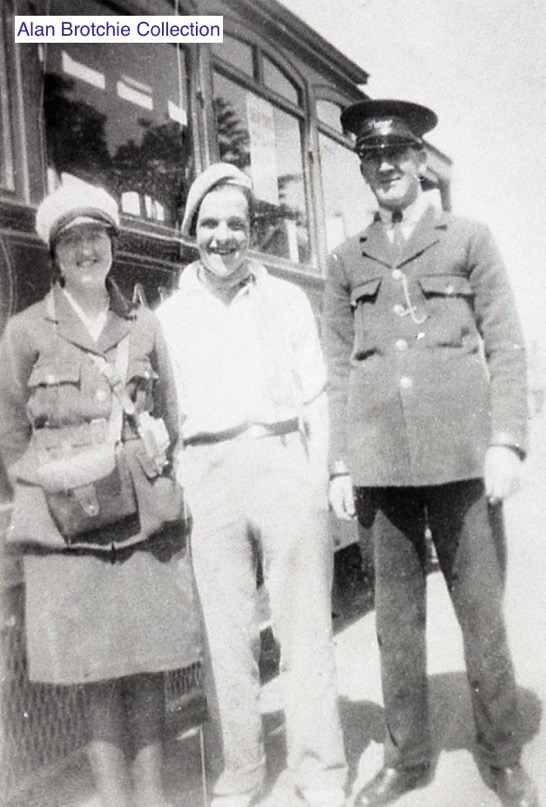
A Wemyss conductress and motorman flanking a rather nattily dressed individual — photo undated, but very probably taken in the late 1920s or early 1930s. In the last few years of the system's life, conductresses wore short single-breasted jackets and knee length skirts, whilst motormen (and presumably conductors too) wore single-breasted jackets with two breast pockets and lapels. Both styles of jacket appear to have borne some kind of embroidered insignia on the collars. The motorman has a 'Driver' grade badge rather 'Motorman'; the latter appears to have been superseded by the former around 1930.
Senior staff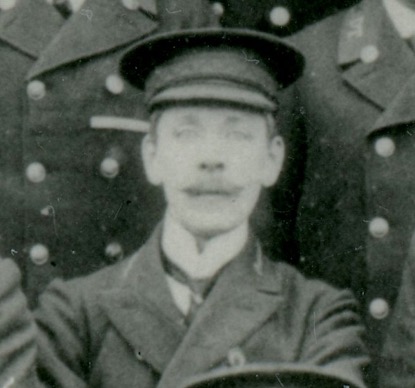
A blow up of the Edwardian staff photo above showing one of the inspectors. With the exception of the grade — embroidered on the collar — the jacket appears to be identical to those issued to the tramcar staff. The cap simply carries a braided hat band, without the grade.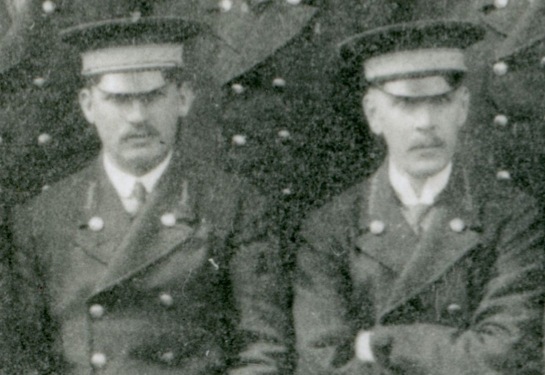
A blow-up of the pre-Great War staff photo above, showing an inspector (left) and the Chief Inspector (right); the latter is very probably the same individual — then an inspector — depicted in the previous photo.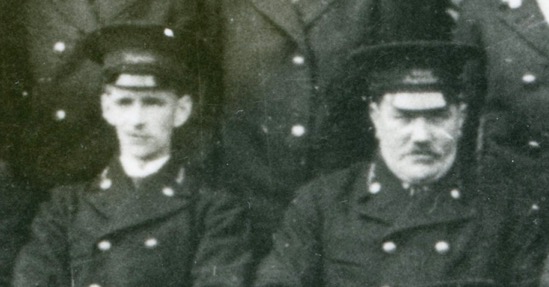
A blow-up from the 1920s staff photo, showing an inspector (left) and the Chief Inspector (right). By this time, the caps carried the grade embroidered on the hat band.
Female staff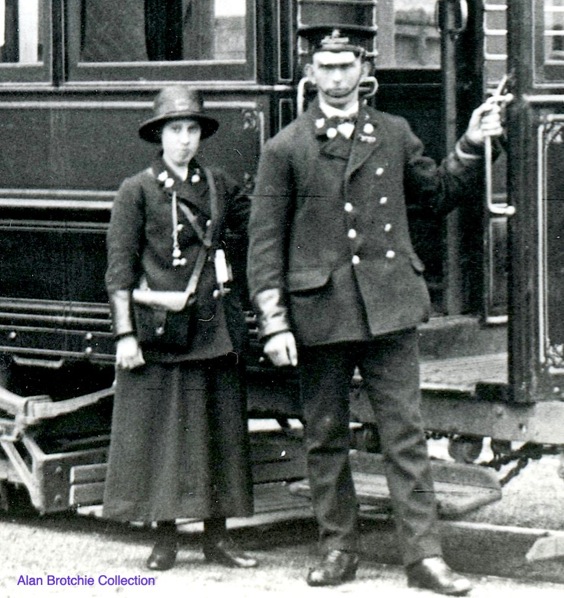
One of Wemyss' first conductresses, with motorman and Tramcar No 6 at Aberhill depot — photo undated, but very probably taken in 1917. The straw bonnet appears to be a rather ugly affair, perhaps explaining the subject's somewhat disgruntled look! Very unusually, the motorman is wearing his chinstrap for the purpose for which it was designed, perhaps the only UK tramway photograph I'm aware of with it being worn thus, rather than simply as an adornment across the top of the cap peak.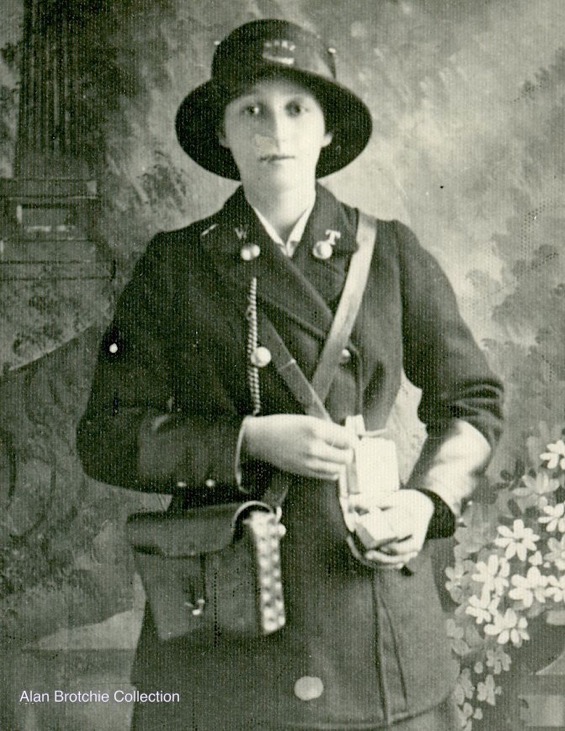
Studio portrait of a Wemyss conductress showing the pudding-basin bonnet, which appears to carry a cap badge with the initials 'W & D T' above 'Conductor' — photo undated, but very probably taken during the Great War.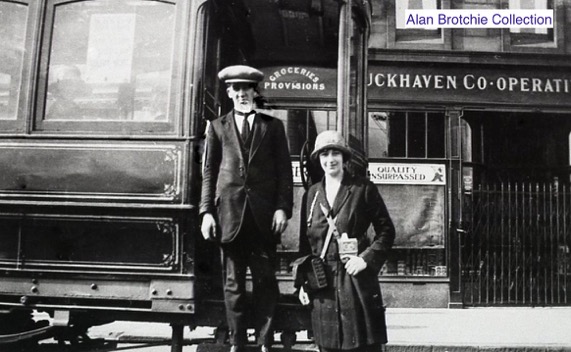
A shot of a conductress wearing informal attire — photo undated, but from the style of the clothing, probably taken in the early 1920s. It is unclear why she is not wearing a uniform, but it may simply have been that new issues were awaiting delivery. The man is probably a friend or relative rather than the motorman.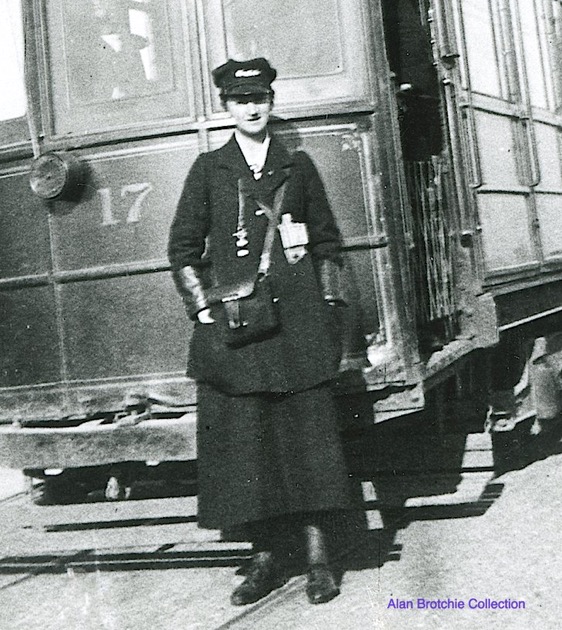
Conductress with Tramcar No 17 — photo undated, but given the long skirt and the fact that the tram is in modified form and still in fairly good condition, probably taken in the early 1920s. The jacket is a long, single-breasted cut, and appears not to bear any badges. The ugly bonnet had also given way by this time, to an American style of cap that bore a standard, off-the-shelf, script-lettering grade badge, 'Conductor'.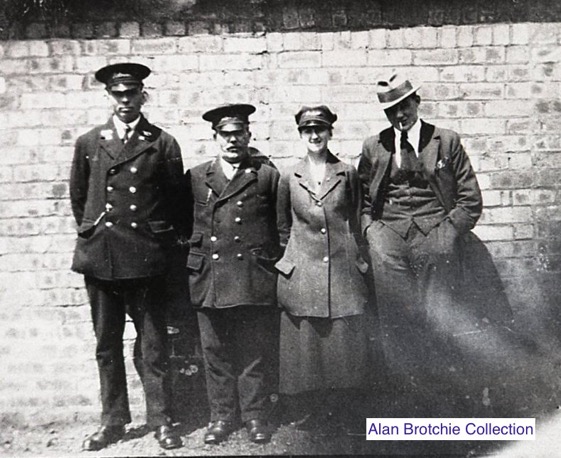
A couple of motormen and a conductress — photo undated, but from the fashions on display, probably taken in the mid-1920s. The style of skirt is still very long, as is the jacket, but the hat is the baggy 'American' type.
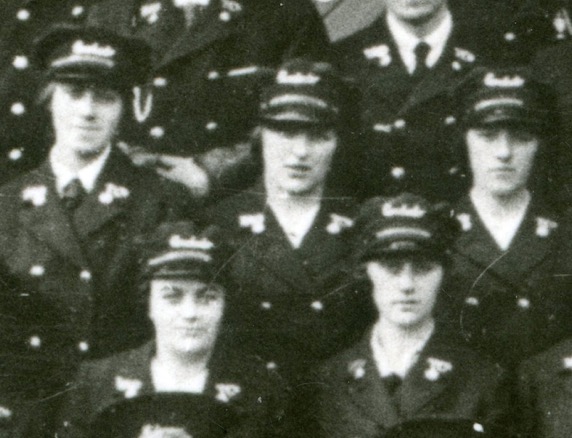
A blow-up of the 1920s depot photo above, showing the baggy American-style caps and script-lettering grade badges. Most of the ladies in the photograph are wearing double-breasted jackets with lapels, though a few are wearing the longer single-breasted jackets.
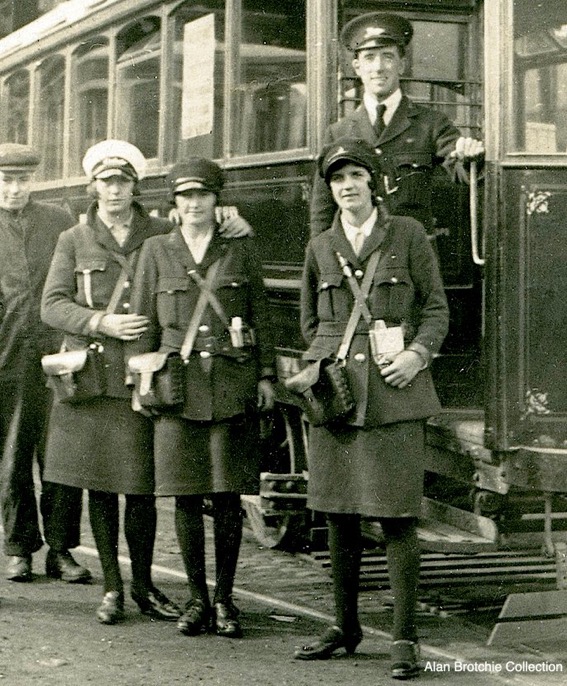
Three conductresses and a motorman pose for the camera with Tramcar No 21 at Aberhill depot — photo undated, but certainly taken no earlier than 1928 when this vehicle was acquired from the recently closed Potteries Electric Tramways. All three ladies are wearing tailored, single-breasted jackets and much shorter skirts than in the previous photos! The ladies' upper collars appear to bear some form of badge, possibly embroidered.